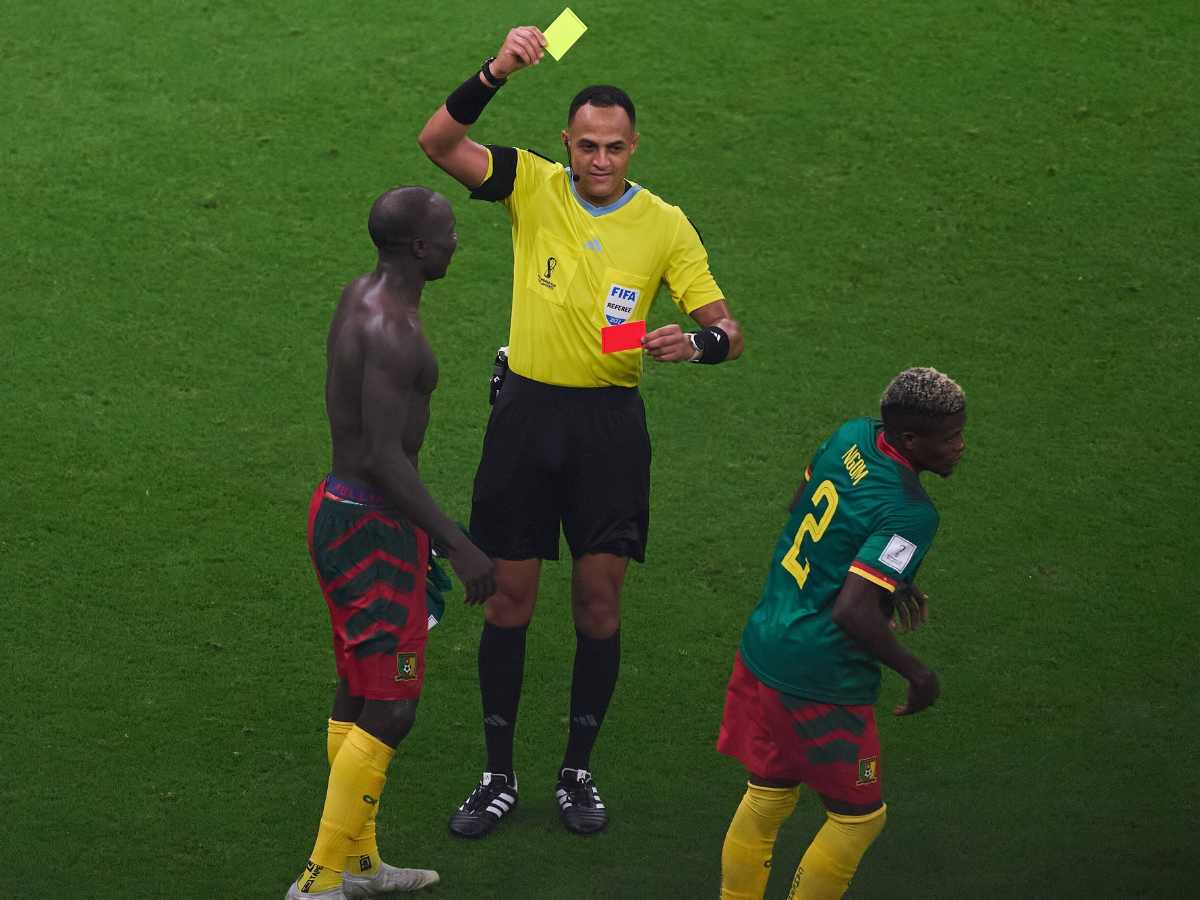Which country has received the most number of Red and Yellow cards in the FIFA World Cup?
Yellow and red cards, which were adopted following a controversy at the 1966 World Cup, are used by referees to assess a player's aggressive behavior on the football pitch.

Red and Yellow card (Fussball Qatar 2022 Cameroon vs Brazil Referee Ismael Elfath of USA shows red card to Vincent ABoubakar of Cameroon during the game Cameroon vs Brazil, Corresponding to Group G of the FIFA World Cup Qatar 2022)
🔍 Explore this post with:
The first rules of football were anointed back in 1881. It was documented that an individual would judge the plays between the two teams and resolve any dispute. He was given the title ‘the referee.’ However, there was no mention of how he would go about making decisions because there was no mention of any method. Later in 1970, former referee Ken Ashton proposed using red and yellow cards for major and minor violent codes of conduct.
The Englishman was driving through the streets of London when he noticed the traffic lights. He had a eureka moment. Ashton thought about using similar color cards during football games. He then spoke with FIFA (the Federation of Football Association), and they opted to use yellow and red cards.
So does that mean players weren’t sent off before that? The answer is a big YES!!! Unlike in modern football, where defenders receive caution just by breathing on the opposition player, it was much more brutal. On top of that, the football pitches were terrible, with less grass and water logged in most places (especially the British Isles). Before the 1970 World Cup in Mexico, referees would eject a player from the game using verbal communication.
Why were the red and yellow cards introduced?
When the host country played Argentina in the quarterfinals of the 1966 World Cup in England four years earlier, uncertainty led to the adoption of red and yellow cards. German referee Rudolf Kreitlein sent off Argentine midfielder Antonio Ubaldo Rattín for allegedly badmouthing English duo Jack and Bobby Charlton.

However, Rattín, a Spanish speaker, did not understand what Kreitlein said (a German/English speaker). So he stayed on the ground, demanding a translator, and the game stopped for 10 minutes. A newspaper report revealed, “We think the referee sent him off, but we couldn’t be sure.“
Eventually, Rattín left the field, and the Charlton brothers received caution. After the implementation of the cards, the first player to receive yellow was the USSR’s Kaji Asatiani while facing Mexico in the 1970 World Cup. Leagues around the globe liked the invention of the card system and adopted it.
Both FIFA and the Referee Association were expecting several sending-offs after the introduction of the new card system. However, not a single player saw any red cards in the 1970 World Cup. And the surprising stats are that the less rigid the rules became as time went on, the more and more players started seeing both yellow and red cards.
For reference, before 1970, the highest number of players sent to a single World Cup was six (Chile, 1962). Compared to that, France 1998 saw 22 players, and Germany 2006 saw 28 players receive red cards or expulsion from the game. Keeping that in mind, here are the top 5 teams with the most red cards in FIFA World Cups.
5. Uruguay
| Year | Player Name | Against |
| 1974 | Julio Montero Castillo | Netharlands |
| 1986 | Miguel Bossio | Denmark |
| 1986 | Jose Batista | Scotland |
| 2010 | Nicolas Lodeiro | France |
| 2014 | Luis Suarez | Ghana |
4. Germany
| Year | Player Name | Against |
| 1986 | Thomas Berthold | Mexico |
| 1990 | Rudi Voller | Netharlands |
| 1998 | Christian Worns | Croatia |
| 2002 | Carsten Ramelow | Cameroon |
| 2010 | Miroslav Klose | Serbia |
| 2018 | Jerome Boateng | Sweden |
3. Brazil
| Year | Player Name | Against |
| 1974 | Luis Periera | Netherlands |
| 1990 | Netherlands | Argentina |
| 1994 | Leonardo Araujo | USA |
| 2002 | Ronaldinho | England |
| 2010 | Kaka | Ivory Coast |
| 2010 | Felipe Melo | Netharlands |
2. Argentina
| Year | Player Name | Against |
| 1982 | Americo Gallego | Italy |
| 1982 | Diego Maradona | Brazil |
| 1990 | Ricardo Giusti | Italy |
| 1990 | Pedro Monzon | West Germany (Germany) |
| 1990 | Gustavo Dezotti | West Germany (Germany) |
| 2002 | Claudio Caniggia | Sweden |
| 2006 | Leandro Cufre | Germany |
1. Cameroon
| Year | Player Name | Against |
| 1990 | Andre Kana Biyik | Argentina |
| 1990 | Benjamin Massing | Argentina |
| 1994 | Rigobert Song | Brazil |
| 1998 | Raymond Kalla | Italy |
| 1998 | Rigobert Song | Chile |
| 1998 | Lauren | Chile |
| 2002 | Patrick Suffo | Germany |
| 2014 | Alex Song | Croatia |







